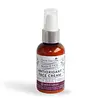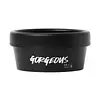What's inside
What's inside
 Key Ingredients
Key Ingredients

No key ingredients
 Benefits
Benefits

 Concerns
Concerns

 Ingredients Side-by-side
Ingredients Side-by-side

Aloe Barbadensis Leaf Juice
Skin ConditioningPersea Gratissima Oil
Skin ConditioningSimmondsia Chinensis Seed Oil
EmollientEmulsifying Wax Nf
Glycerin
HumectantElaeis Guineensis Oil
EmollientStearic Acid
CleansingTocopherol
AntioxidantHelianthus Annuus Seed Oil
EmollientAzadirachta Indica Seed Oil
Skin ConditioningRosmarinus Officinalis Leaf Extract
AntimicrobialPhenoxyethanol
PreservativeRosa Damascena Flower Water
MaskingRosa Rubiginosa Seed Oil
EmollientDaucus Carota Sativa Seed Oil
EmollientTriticum Vulgare Germ Oil
EmollientRetinyl Acetate
Skin ConditioningAscorbyl Palmitate
AntioxidantPanthenol
Skin ConditioningAllantoin
Skin ConditioningSalix Alba Bark Extract
AstringentAlcohol
AntimicrobialXanthan Gum
EmulsifyingTetrasodium Glutamate Diacetate
Aloe Barbadensis Leaf Juice, Persea Gratissima Oil, Simmondsia Chinensis Seed Oil, Emulsifying Wax Nf, Glycerin, Elaeis Guineensis Oil, Stearic Acid, Tocopherol, Helianthus Annuus Seed Oil, Azadirachta Indica Seed Oil, Rosmarinus Officinalis Leaf Extract, Phenoxyethanol, Rosa Damascena Flower Water, Rosa Rubiginosa Seed Oil, Daucus Carota Sativa Seed Oil, Triticum Vulgare Germ Oil, Retinyl Acetate, Ascorbyl Palmitate, Panthenol, Allantoin, Salix Alba Bark Extract, Alcohol, Xanthan Gum, Tetrasodium Glutamate Diacetate
Citrus Aurantium Dulcis Peel Cera
EmollientOlea Europaea Fruit Oil
MaskingStearic Acid
CleansingOenothera Biennis Oil
EmollientPersea Gratissima Oil
Skin ConditioningGlycerin
HumectantCocos Nucifera Oil
MaskingCitrus Limon Peel
MaskingTriticum Vulgare Germ Oil
EmollientSimmondsia Chinensis Seed Oil
EmollientCucumis Sativus Juice
EmollientCitrus Aurantium Amara Peel
Skin ConditioningCommiphora Myrrha Resin
MaskingTriethanolamine
BufferingCetearyl Alcohol
EmollientGeraniol
PerfumingFarnesol
PerfumingLimonene
PerfumingLinalool
PerfumingHydroxycitronellal
PerfumingParfum
MaskingMethylparaben
PreservativePropylparaben
PreservativeCitrus Aurantium Dulcis Peel Cera, Olea Europaea Fruit Oil, Stearic Acid, Oenothera Biennis Oil, Persea Gratissima Oil, Glycerin, Cocos Nucifera Oil, Citrus Limon Peel, Triticum Vulgare Germ Oil, Simmondsia Chinensis Seed Oil, Cucumis Sativus Juice, Citrus Aurantium Amara Peel, Commiphora Myrrha Resin, Triethanolamine, Cetearyl Alcohol, Geraniol, Farnesol, Limonene, Linalool, Hydroxycitronellal, Parfum, Methylparaben, Propylparaben
 Reviews
Reviews

Ingredients Explained
These ingredients are found in both products.
Ingredients higher up in an ingredient list are typically present in a larger amount.
Glycerin is already naturally found in your skin. It helps moisturize and protect your skin.
A study from 2016 found glycerin to be more effective as a humectant than AHAs and hyaluronic acid.
As a humectant, it helps the skin stay hydrated by pulling moisture to your skin. The low molecular weight of glycerin allows it to pull moisture into the deeper layers of your skin.
Hydrated skin improves your skin barrier; Your skin barrier helps protect against irritants and bacteria.
Glycerin has also been found to have antimicrobial and antiviral properties. Due to these properties, glycerin is often used in wound and burn treatments.
In cosmetics, glycerin is usually derived from plants such as soybean or palm. However, it can also be sourced from animals, such as tallow or animal fat.
This ingredient is organic, colorless, odorless, and non-toxic.
Glycerin is the name for this ingredient in American English. British English uses Glycerol/Glycerine.
Learn more about GlycerinPersea Gratissima Oil is also known as avocado oil.
Avocado Oil has antioxidant properties. It is mostly made up of the glycerides of fatty acids. About 67% of these fatty acids is made up of oleic acid. Palmitic acid and linoleic acid are also present.
These fatty acids help hydrate and soften the skin. It may increase collagen content in the skin. Collagen helps keep your skin plump and firm. This ingredient helps reduce inflammation and has not shown to clog pores.
This ingredient may not be fungal-acne safe due to its high fatty acid content.
Avocados also have B vitamins, vitamin K, vitamin C, vitamin E, and potassium.
Learn more about Persea Gratissima OilThis oil comes from the seeds of the desert shrub called Jojoba. It is more commonly known as jojoba oil, a non-comedogenic oil.
Jojoba oil does not contain fragrance and has many fatty-acids, making it a great soothing ingredient.
It also contains Vitamin E, a great moisturizing ingredient. Vitamin E is also an antioxidant and protects your skin against oxidative damage.
This ingredient humectant properties, meaning it helps draw moisture from the air. This helps keep your skin hydrated.
While jojoba has antibacterial properties, it is only able to kill some strains of bacteria.
Studies also show it helps in wound healing. In fact, Indigenous cultures have used jojoba as a moisturizer and to help treat burns for centuries.
Fun fact: Jojoba oil similar to natural human skin sebum, so it has a great effect on dry skin. It is also promising with helping to regulate sebum production.
Due to its fatty acid content, Jojoba oil may not be fungal acne safe. We recommend speaking with a professional if you have any concerns.
Learn more about Simmondsia Chinensis Seed OilStearic Acid is a fatty acid. It is an emollient, emulsifier, and texture enhancer.
As an emollient, stearic acid helps soften skin. It aids the skin's protective barrier by preventing water loss. It also provides a gentle cleansing effect without stripping away natural oils.
Stearic acid may also be used to enhance the texture of products. It can add volume and stabilize ingredients such as water and oil. This can help water and oil ingredients from separating.
Sources of stearic acid include animal or vegetable fats/oils such as coconut or shea. It can be naturally found in butter, cocoa butter, shea butter, vegetable fats, and animal tallow.
This ingredient may not be Malassezia folliculitis, or fungal-acne safe.
Learn more about Stearic AcidWheatgerm oil is a yellow/reddish oil derived from germs on the common wheat. It is rich in Vitamin E, an ingredient with many skin benefits.
About 80% of the oil is made up of fatty acids. The majority of these include linoleic acid and linolenic acid.
Studies show this oil can aid in wound healing and soothing inflammation.
This ingredient may not be acne or fungal-acne safe.
Sometimes, the Vitamin E derived from wheat germ can contain gluten. However, most plant derived oil is processed to remove all proteins.
Learn more about Triticum Vulgare Germ Oil